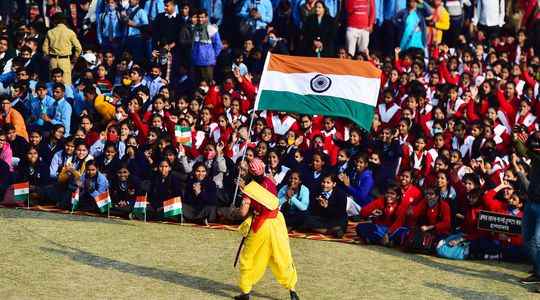“India, beloved country, for you we will sacrifice our body and our spirit.” The extreme lyrics of this patriotic tune contrast with the small voices that take it up in unison. It is barely 9 a.m. and the melody sung by these still sleepy primary school students is quickly derailed. Dressed in their gray uniforms, some sit quietly on the aging wooden benches in the classroom. Others are taking the course online due to the pandemic. Sangeeta Rana, their singing teacher, a bindi red on the forehead and his glasses on the tip of the nose, takes them again until the result is satisfactory. Here, the day systematically begins with a “prayer” to the glory of the nation.
Located in a district of southern New Delhi, Lajpat Nagar, this school belongs to a national network of 12,000 schools managed by the “education” branch of the Rashtriya Swayamsevak Sangh (association of national volunteers). Better known by the acronym RSS, this organization with paramilitary methods is the ideological matrix of the Indian People’s Party (BJP), the Hindu nationalist formation of Indian Prime Minister Narendra Modi. “These schools mix classical and theological education; it is one of the most extensive school networks in the country,” explains Nilanjan Mukhopadhyay, author of several books on Hindu nationalism.
“We are connected to our heritage; in addition to the classical curriculum taught in other Indian schools, we emphasize physical activity, yoga, moral values, arts and Sanskrit [NDLR : l’une des langues les plus anciennes au monde]”, explains Ashok Kumar Mittal, the principal of the school of Lajpat Nagar, who proudly shows his establishment of more than 300 students.
“Stir up hatred”
The first school of its kind was created in 1952 in Gorakhpur, Uttar Pradesh, a state that the BJP has transformed in recent years into a laboratory of Hindu nationalism. In this region, where anti-Muslim diatribes are particularly violent, the regional elections currently taking place there will serve as a test for the Prime Minister. The purpose of these establishments ? “Building a generation of young men and women committed tohindutva“, an ideology that defends the idea of a supremacy and a Hindu nation. And this, in a secular and multi-confessional India, with a Hindu majority, which has some 200 million Muslims, or about 14% of the population.
At school, this ideology translates into a rewriting of the past. “We want to move away from a story that dwells on our defeats to focus on a story of our victories,” admits frankly Shriram Araokar, secretary general of the education branch of the RSS. And to clarify his thought: “Why should we call Akbar ‘Great’?” [NDLR : surnom de l’empereur moghol Akbar (1542-1605), figure de l’apogée de l’expansion musulmane en Inde et réputé pour sa tolérance religieuse] “For us, Maharana Pratap is great!” [NDLR : en référence au chef hindou (1540-1597) connu pour sa résistance militaire aux Moghols]
“These schools take liberties with the facts in order to stir up hatred against religious minorities”, denounces Aditya Mukherjee, professor of history attached to the university of Jawaharlal Nehru, who points to “an attempt to create a glorious past which does not would have been only Hindu and to portray everything that ensued as horrible”. The period of the Mughal Empire – therefore Muslim – is thus defined as obscure. “At that time, however, India rivaled the rest of the world, whether in science or in the arts,” continues this specialist.
According to nationalists, many of the discoveries of modern medicine date back to ancient India, thousands of years ago. The existence of Ganesh, the god with the body of a man and the head of an elephant, would prove that cosmetic surgery was invented in ancient India. Just as the birth, out of his mother’s womb, of Karna – hero of the Indian epic Mahabharata – would demonstrate the invention of medically assisted procreation. Theories publicly taken up by the Indian Prime Minister, who cut his teeth in the ranks of the RSS.
A more powerful ideology
However, the teaching of this organization welcomes pupils of other denominations. And wants to be a social elevator. “Overall, the majority comes from the underprivileged categories of society: we train the children of fruit and vegetable vendors, migrant workers…”, lists Ashok Kumar Mittal, the school’s principal. According to him, all Indian institutions should adopt his type of teaching.
An ad hoc committee was also created by the Ministry of Education in September 2021, in order to frame the new programs of schools recognized by the government. Among its members is Govind Prasad Sharma, former chairman of the education wing of the RSS. “This body has always tried to impose its vision of history, but today this ideology has become more powerful and is spreading like wildfire,” warns Aditya Mukherjee. “Everywhere in Indian society, entities affiliated with the RSS are present: in trade unions, farmers’ organizations and education”, abounds Nilanjan Mukhopadhyay.
There is certainly resistance in the states where the BJP is not in power. In 2018, the local government of West Bengal, for example, ordered the closure of 125 schools with links to the RSS. But a movement is underway. And at Lajpat Nagar School, when the bell rings at midday, students will sing a new patriotic prayer.
